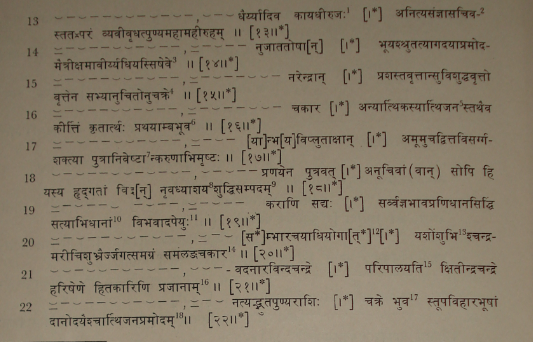|
INSCRIPTIONS OF THE MINISTERS AND FEUDATORIES OF THE
VATSAGULMA BRANCH

____________________
1 This expression was completely read for the first time by me.
2 This expression has been read variously, viz., अनित्यसंज्ञासचिव- (Bhau Daji), अचिंत्यसंज्ञासचिव-
(Bhagvanlal) and अचिंत्यसंज्ञासचिव- (Bühler). The second अक्षर is undoubtedly नि, and the fifth ज्ञा, the
upturned curve of the medial ā being unmistakable. The correct reading is therefore the one given
by Bhau Daji, though his interpretation was wrong.
3 Meter of verse 14 and 15 : Upajāti.
4 All previous editors read साम्यक्षुभितोनुचक्रे, but the reading is not supported by the facsimile and
gives no good sense. The third akshara is clearly नु and the fourth probably चि. The only possible
reading appears to be सभ्यानुचितोनुचक्रे.
5 Bhau Daji read अन्यार्थिकस्यार्थिजन-, but Bhagvanlal omitted the second akshara, while Bühler gave
आर्त्थिकस्यार्थिजन which does not, however, suit the meter. The aksharas are quite unmistakable here.
6 Meter of vv. 16 and 17 :- Indravajrā (or Upajāti).
7 Bhagvanlal read पुत्राभिचेष्टान् and Bühler, पुत्राधिचेष्टान् but neither of these suits the context. Besides,
the akshara before ष्टा is clearly वे, not चे, thus showing the correct reading to be as given above.
8 Read नृवद्ध-
9 Metre : Vaṁśīastha.
10 Bhau Daji read सत्याभिधानानि, and Bhagvanlal, सत्याभिधानाभिभवात्. The context shows that this
verse gives the words of the parrot, pointing out the obstacles of wealth in the a attainment of the highest
goal.
11 Metre : Indravajrā (or Upajāti ).
12 Bhagvanlal read म्वारचयाधियोग:, while Bühler was certain only about the aksharas च and योग:. The
subscript member of the first legible akshara is clearly भ, and the use of अधियोग suggested that the expression ended in the ablative, though the final त् is not legible.
13 Bhagvanlal read यशोम्बुभि:, which Bühler corrected into यशोंशुमि:. The facsimile leaves no doubt
that Bühler’s reading is correct.
14 Meter : Upēndravajrā or Upajāti.
15 There is a redundant vertical stroke after ल.
16 Metre : Aupachchhandasika.
17 Bühler’s emandation भुव: is unnecessary as the visarga is dropped by the Vārttika on Pāṇini VIII,
3, 36.
18 Metre of verses 22 and 23: Indravajrā (or Upajāti).
|